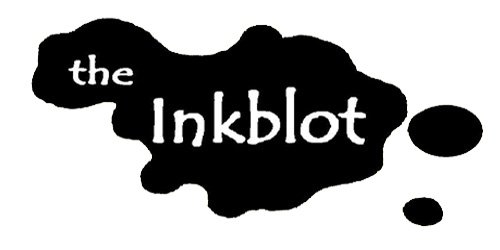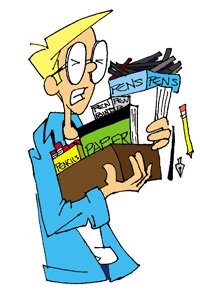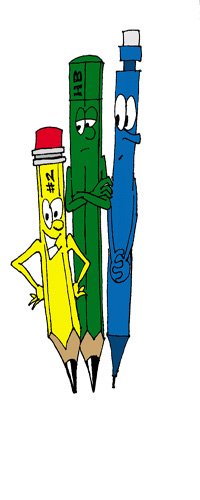
August 12, 2008
Issue #1: The Perfect Pencil
The Inkblot is your cartooning information resource. From art supplies to drawing lessons to tips from the pros, you'll learn what it takes to be a cartoonist!
If you like this ezine, please tell your friends and family about it. Remember, it's free! If this was forwarded to you by a friend, do me (and yourself) a favor and subscribe! Just click the link below:
Inkblot Subscribe Page
Contents:
- 1. The Road to Success
- 2. Introduction to Art Supplies
- 3. The Pencil
The Road to Success
Welcome to the first issue of The Inkblot, your companion into the wild and wonderful world of cartooning!The purpose of this ezine is to show you the golden path of success as a cartoonist. The road can be long and difficult, and there are many paths along the way that can lead to deadends, so it's helpful to have someone with you that has been there!
Remember this as we begin: cartooning can be tons of fun, but it's only as fun as you make it! You have to want to draw cartoons. As you learn and perfect your abilities, you're going to run into difficulties.
There will be times you'll become discouraged. You may feel you aren't good enough. There might be days where it seems you can't think up any good ideas. As you get start submitting your work to magazines and syndicates, cartoons you thought were awesome might be rejected. Ignore all these feelings! Everyone has bad days, even the best of the best. The trick is to sharpen your pencil and keep on drawing! Your passion for your craft is what will drive you forward!
As we begin our journey, let's discuss the tools of the trade...
Art Supplies!
 Art supplies are extremely important to the cartoonist, because without them, the cartoon can't be brought into existence! Over the next several issues, we'll be discussing them and their importance.
Art supplies are extremely important to the cartoonist, because without them, the cartoon can't be brought into existence! Over the next several issues, we'll be discussing them and their importance. When you get right down to it, all the cartoonist really needs to draw a cartoon are a few simple supplies that can be found anywhere:
- Pencil
- Pen
- Eraser
- Paper
- Drawing Surface
- An Idea
Of course, if you're just practicing, drawing for fun, or on a strict budget, most--if not all--of these things can be found in the stationary aisle of your local grocery or outlet store. When I first started drawing, I drew with whatever I could find around the house. Even today, most of my supplies are very inexpensive ones that I get at the local grocery store.
However, if you're really serious about cartooning, and you want your final drawing to be professional, then professional supplies are a must! The best thing to do, especially if you're just starting out, is to study the professional cartoons out there, and what are used to draw them. In future ezine issues, we'll be highlighting professional cartoonists of both yesterday and today, to find out how they work, and what supplies they use.
In this issue, let's discuss...
The Pencil
 As an artist, the pencil is the first thing I pick up when I begin a drawing or cartoon. In fact, ever since I was a kid, the very sight of a pencil would fill me with excitement! The type of pencil you use can be very important, because different pencils have very different effects.
As an artist, the pencil is the first thing I pick up when I begin a drawing or cartoon. In fact, ever since I was a kid, the very sight of a pencil would fill me with excitement! The type of pencil you use can be very important, because different pencils have very different effects. When looking for a pencil, you first have to decide what you're going to use it for.
Will it be for basic sketching? If so, you'll want a pencil that is moderately soft and easy to erase.
Will you be doodling? Depending on what you're going to be doing with your doodle, you can use almost any pencil. However, since I sometimes end up inking my doodles, I like a harder pencil, but not so hard that it digs into the paper.
Will it be your final drawing before inking? In this case, you'll do best with a medium pencil that will make a good line, but that is still easy to erase after you ink over it.
Based on my many years of drawing experience, here are some pencil types that I've used the most:
The Mechanical Pencil
This is a good choice for all-around use. I've used it for sketching, doodling, and final art. It has a uniform line that's easy to erase. It takes a little practice to use, however, because if you press too hard, the thin point can dig into the paper, making an etching, so your sketch can still be seen even after erasing! Also, the point can break pretty easily and you'll find yourself having to do a lot of clicking to advance it.The advantage of using this type of pencil is that they're cheap! You can get a package of 10 or more at the supermarket for just a few bucks!
Number 2
Here's another good pencil for everything. It's the pencil I use the most, because they can be found almost anywhere. Like the mechanical pencil, it's easy to erase, and is soft enough to use for both sketching and final art on almost any surface. It's easy to erase, but isn't hard enough to dig into the paper. You have to be careful when buying this type of pencil, however, because there are many companies that make them. If you go too cheap, then the point breaks easily and doesn't hold up too when when sharpening. It also doesn't keep it's point as well as other types of pencils, so you'll find yourself going through them pretty quickly. Different brands use different types of wood (some even use plastic!) so you want pencil made with a harder wood that doesn't break easily. I have my favorite brands, which I'll discuss later.HB
This is one of my favorite pencils. It's a medium pencil that's still easy to erase, but it holds it's point longer than the mechanical or number 2 pencils. I use this pencil for my final drawing before inking. This pencil can sometimes be found in supermarkets or outlet stores; but you'll probably need to go to an art supply store. Also, they're often sold separately, or in packs of two, so they tend to be more expensive than the number 2.2B
This is another pencil that can be used for almost anything. I use it occasionally for cartooning, but find myself using it more for sketching and doodling rather than for final art, because it's softer than the number 2 or HB. It still holds a good line, and is still pretty easy to erase. This type of pencil is only sold in art supply stores, and is a bit more expensive than the number 2 pencil. Sometimes you find it sold in sets with other pencil types.3B - 8B
I don't use these very often, because they aren't practical for cartooning. They are very soft, so they are difficult to erase. The softer the pencil, the darker the line, and the harder it is to erase. I use these pencils when I'm just sketching or doodling, and not planning to ink my work. I sometimes like to sit outside and sketch trees, plants, or people as they walk by, and they're great because they give a dark line. Since I'm just sketching when I use these pencil types, I don't bother to erase.The bad thing about these pencil types is that they don't hold a point very long, so I'm constantly sharpening them. They can expensive, and are sold singly or in sets with other pencil types, and can generally be found only in art stores.
H - 4H
The "H" family of pencils have a harder lead than the ones above, so they make a much lighter line. The H through 4H pencil types aren't hard enough to dig into the paper much, but they aren't practical for cartooning, because of the lightness of the line. The lightness of the line could tempt you to press too hard, and you'll make an etching that can't be erased. I've used these for sketching and for tracing, but never for final work.One advantage: they keep a good point, and don't require much sharpening.
One disadvantage: they aren't always easy to find, and can be expensive.
5H - 10H
These aren't practical pencils to use for cartooning. I also find they're difficult to find, even in art supply stores. Remember, the harder the pencil, the lighter the line and the more it digs into the paper. I stay away from the harder types of pencils and stick to mediums, because they're the easiest to use.So Which One Is Best?
 As you can see above, there are a lot of different pencils out there, for many different types of art. As with all art supplies, I can talk your ears off about them, and you can read all the art books in the world, but you'll never find that forever elusive "perfect pencil", because there isn't one! The only way you're going to find out which pencil is best for you is by buying a bunch of different ones, and experiment!
As you can see above, there are a lot of different pencils out there, for many different types of art. As with all art supplies, I can talk your ears off about them, and you can read all the art books in the world, but you'll never find that forever elusive "perfect pencil", because there isn't one! The only way you're going to find out which pencil is best for you is by buying a bunch of different ones, and experiment! If you're already using a particular type of pencil that works for you, then don't stop just because someone else might be using a different one. Also, don't take my words as gospel; these are only based on my experiences!
My Favorites...
Like I said in the beginning, I have my favorite pencil companies. The pencil I love the most, and in my experience has always worked well for me is made by:Dixon Ticonderoga!
I first came across this pencil while I was in elementary school, but it's been around for a long time. I'll have to admit that the first thing that attracted me to it was its beauty; the company name is written on the side of the pencil in gorgeously shiny emerald script. The metal ring holding the eraser on the end is also green. It was only later that I found out how wonderfully this pencil performs. It makes a very smooth line, holds up great in the sharpener--even the electric ones--and keeps its point longer than any other number 2 pencil I've ever used! It's relatively inexpensive, and is sold in packs ranging from 2 to 48! For more information about this awesome pencil, visit the Dixon Ticonderoga website at
www.dixonusa.com.
Another great pencil company is Faber-Castell. Their pencils are very well made, and hold up really well to the sharpener. It takes a lot for it to break, and I love the nice lines it makes. Check out their website at
www.faber-castellusa.com.
Well, that's it for this issue. I hope you found it useful and interesting. Now march right over to your nearest art supply store and grab up a bunch of pencils! Then start drawing like crazy!
We'll see you next month!
Michael Richards
www.coolcartooning.com